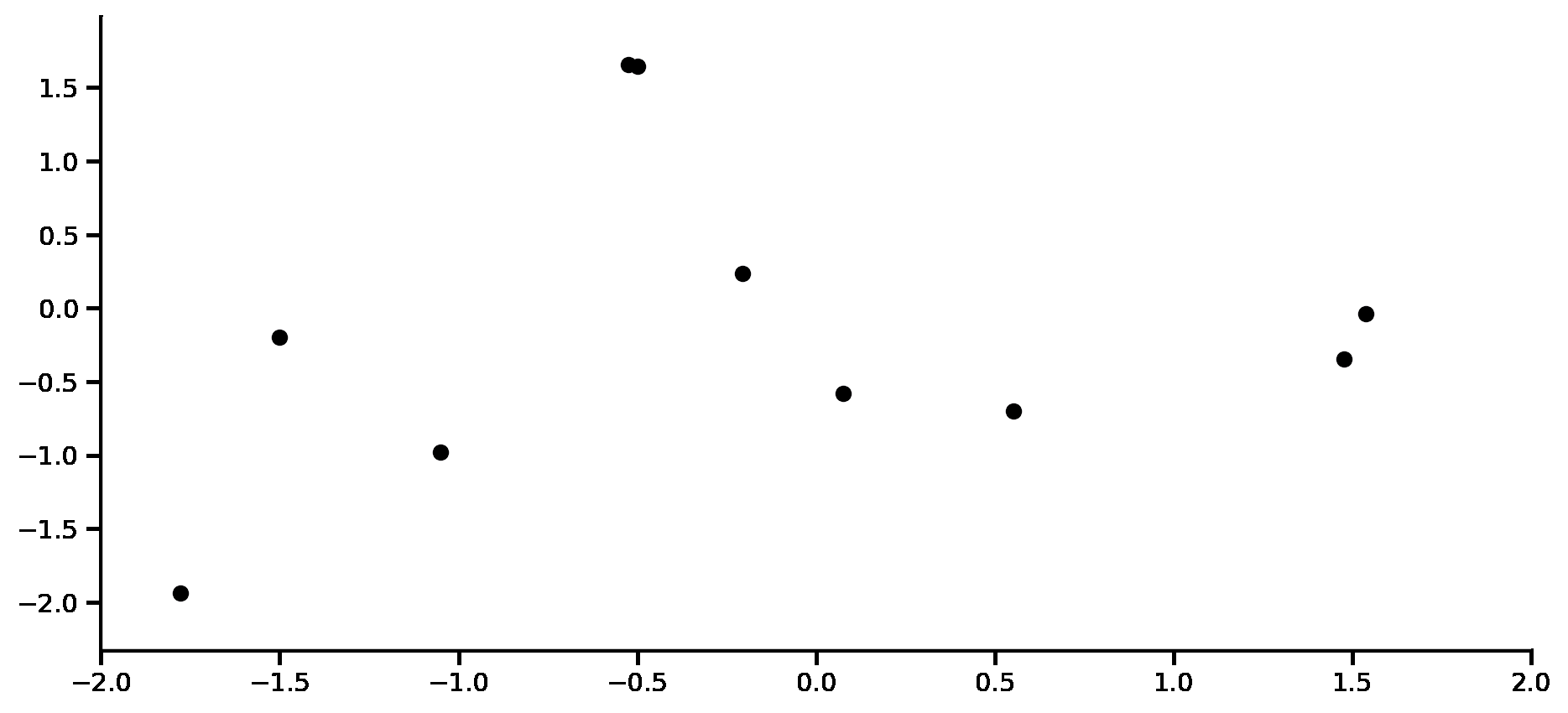Convolutional Conditional Neural Process (ConvCNP)¶
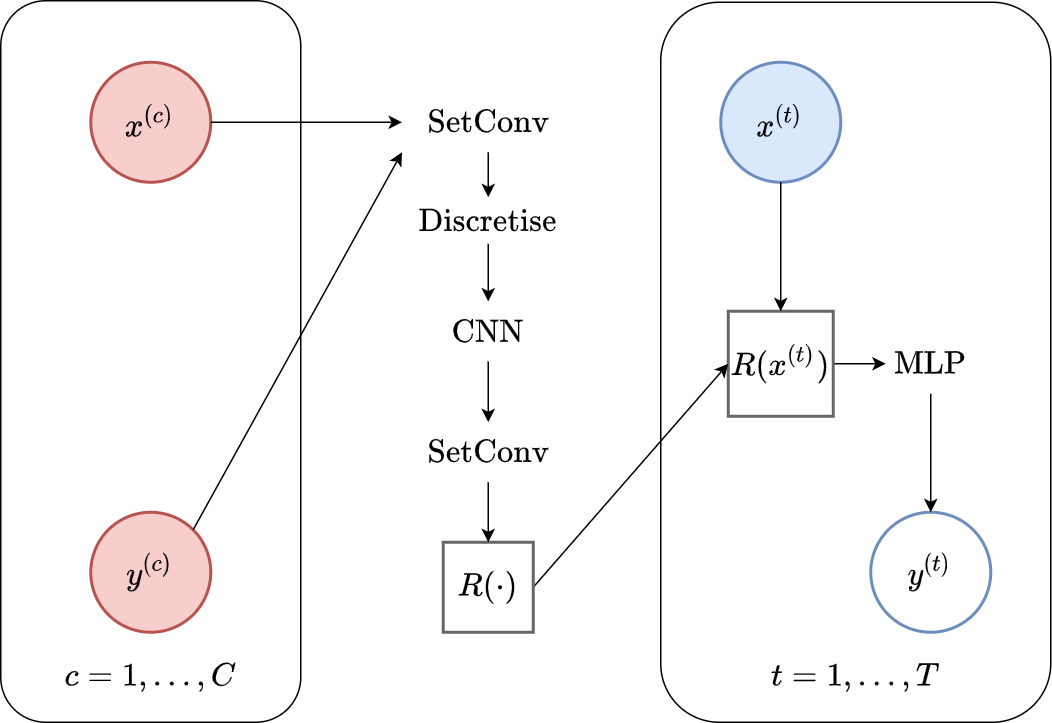
Fig. 56 Computational graph for Convolutional Conditional Neural Processes.¶
In this notebook we will show how to train a ConvCNP on samples from GPs and images using our framework, as well as how to make nice visualizations. ConvCNPs are CNPFs that use a SetCov+CNN+SetCov encoder (computational graph in Fig. 56).
We will follow quite closely the previous CNP notebook, but will also run a larger model (on CelebA128) to test super resolution.
%matplotlib inline
%config InlineBackend.figure_format = 'retina'
import logging
import os
import warnings
import matplotlib.pyplot as plt
import torch
os.chdir("../../")
warnings.filterwarnings("ignore")
warnings.simplefilter("ignore")
logging.disable(logging.ERROR)
N_THREADS = 8
IS_FORCE_CPU = False # Nota Bene : notebooks don't deallocate GPU memory
if IS_FORCE_CPU:
os.environ["CUDA_VISIBLE_DEVICES"] = ""
torch.set_num_threads(N_THREADS)
Initialization¶
Let’s load all the data. For more details about the data and some samples, see the data notebook. In addition, we’ll use Celeba128 dataset.
from utils.ntbks_helpers import get_all_gp_datasets, get_img_datasets
# DATASETS
# gp
gp_datasets, gp_test_datasets, gp_valid_datasets = get_all_gp_datasets()
# image
img_datasets, img_test_datasets = get_img_datasets(["celeba32", "mnist", "zsmms"])
imgXL_datasets, imgXL_test_datasets = get_img_datasets(["celeba128"])
Now let’s define the context target splitters, which given a data point will return the context set and target set by selecting randomly selecting some points and preprocessing them so that the features are in \([-1,1]\). We use the same as in CNP notebook, namely all target points and uniformly sampling in \([0,50]\) and \([0,n\_pixels * 0.3]\) for 1D and 2D respectively.
The only difference with the previous notebooks is that for the “on the grid” case (images) we will return the mask (instead of preprocessing the context sets) which facilitates the implementation by running a standard CNN. As we do not preprocess the pixels to \([-1,1]\), we do not have to deal with ZSMM differently despite the fact that the size of training and testing images is different.
from npf.utils.datasplit import (
CntxtTrgtGetter,
GetRandomIndcs,
GridCntxtTrgtGetter,
RandomMasker,
get_all_indcs,
no_masker,
)
from utils.data import cntxt_trgt_collate, get_test_upscale_factor
# CONTEXT TARGET SPLIT
get_cntxt_trgt_1d = cntxt_trgt_collate(
CntxtTrgtGetter(
contexts_getter=GetRandomIndcs(a=0.0, b=50), targets_getter=get_all_indcs,
)
)
get_cntxt_trgt_2d = cntxt_trgt_collate(
GridCntxtTrgtGetter(
context_masker=RandomMasker(a=0.0, b=0.3), target_masker=no_masker,
),
is_return_masks=True, # will be using grid conv CNP => can work directly with mask
)
get_cntxt_trgt_2dXL = cntxt_trgt_collate(
GridCntxtTrgtGetter(context_masker=RandomMasker(a=0.0, b=0.05)),
is_return_masks=True, # use only 5% of the data because much easier task in larger images
)
Let’s now define the models. For all the models we: (i) use a 4 hidden layer MLP for the decoder; (ii) always use hidden representations of size (or number of channels) 128 dimensions. The implementation of the encoder (to get a target dependent representation of the context set) differs slightly depending on the dataset:
Off the grid (GP datasets):
Set convolution with normalized Gaussian RBF kernel to process context set.
Uniformly discretize (64 points per unit) the output function to enable the use of standard CNNs.
10 layer ResNet to process the functional representation.
Set Convolution with normalized Gaussian RBF kernel to enable querying at each target feature.
On the grid (MNIST, CelebA32):
Apply the mask to the input image, concatenate the mask as a new (density) channel, and apply a convolutional layer.
10 layer ResNet to process the functional representation.
Large model (CelebA128): Same as “on the grid” but with a 24 layer ResNet.
Full translation equivariance (ZSMM): Same as “on the grid” but with circular padding to ensure translation equivariance of the CNN (see appendix D.6 [GBF+20])
from functools import partial
from npf import ConvCNP, GridConvCNP
from npf.architectures import CNN, MLP, ResConvBlock, SetConv, discard_ith_arg
from npf.utils.helpers import CircularPad2d, make_abs_conv, make_padded_conv
from utils.helpers import count_parameters
R_DIM = 128
KWARGS = dict(
r_dim=R_DIM,
Decoder=discard_ith_arg( # disregards the target features to be translation equivariant
partial(MLP, n_hidden_layers=4, hidden_size=R_DIM), i=0
),
)
CNN_KWARGS = dict(
ConvBlock=ResConvBlock,
is_chan_last=True, # all computations are done with channel last in our code
n_conv_layers=2, # layers per block
)
# off the grid
model_1d = partial(
ConvCNP,
x_dim=1,
y_dim=1,
Interpolator=SetConv,
CNN=partial(
CNN,
Conv=torch.nn.Conv1d,
Normalization=torch.nn.BatchNorm1d,
n_blocks=5,
kernel_size=19,
**CNN_KWARGS,
),
density_induced=64, # density of discretization
**KWARGS,
)
# on the grid
model_2d = partial(
GridConvCNP,
x_dim=1, # for gridded conv it's the mask shape
CNN=partial(
CNN,
Conv=torch.nn.Conv2d,
Normalization=torch.nn.BatchNorm2d,
n_blocks=5,
kernel_size=9,
**CNN_KWARGS,
),
**KWARGS,
)
# full translation equivariance
Padder = CircularPad2d
model_2d_extrap = partial(
GridConvCNP,
x_dim=1, # for gridded conv it's the mask shape
CNN=partial(
CNN,
Normalization=partial(torch.nn.BatchNorm2d, eps=1e-2), # was getting NaN
Conv=make_padded_conv(torch.nn.Conv2d, Padder),
n_blocks=5,
kernel_size=9,
**CNN_KWARGS,
),
# make first layer also padded (all arguments are defaults besides `make_padded_conv` given `Padder`)
Conv=lambda y_dim: make_padded_conv(make_abs_conv(torch.nn.Conv2d), Padder)(
y_dim, y_dim, groups=y_dim, kernel_size=11, padding=11 // 2, bias=False,
),
**KWARGS,
)
# large model
model_2d_XL = partial(
GridConvCNP,
x_dim=1, # for gridded conv it's the mask shape
CNN=partial(
CNN,
Conv=torch.nn.Conv2d,
Normalization=torch.nn.BatchNorm2d,
n_blocks=12,
kernel_size=9,
**CNN_KWARGS,
),
**KWARGS,
)
n_params_1d = count_parameters(model_1d())
n_params_2d = count_parameters(model_2d(y_dim=3))
n_params_2d_XL = count_parameters(model_2d_XL(y_dim=3))
print(f"Number Parameters (1D): {n_params_1d:,d}")
print(f"Number Parameters (2D): {n_params_2d:,d}")
print(f"Number Parameters (2D XL): {n_params_2d_XL:,d}")
Number Parameters (1D): 276,612
Number Parameters (2D): 340,721
Number Parameters (2D XL): 722,417
For more details about all the possible parameters, refer to the docstrings of ConvCNP and GridConvCNP and the base class NeuralProcessFamily.
# ConvCNP Docstring
print(ConvCNP.__doc__)
Convolutional conditional neural process [1].
Parameters
----------
x_dim : int
Dimension of features.
y_dim : int
Dimension of y values.
density_induced : int, optional
Density of induced-inputs to use. The induced-inputs will be regularly sampled.
Interpolator : callable or str, optional
Callable to use to compute cntxt / trgt to and from the induced points. {(x^k, y^k)}, {x^q} -> {y^q}.
It should be constructed via `Interpolator(x_dim, in_dim, out_dim)`. Example:
- `SetConv` : uses a set convolution as in the paper.
- `"TransformerAttender"` : uses a cross attention layer.
CNN : nn.Module, optional
Convolutional model to use between induced points. It should be constructed via
`CNN(r_dim)`. Important : the channel needs to be last dimension of input. Example:
- `partial(CNN,ConvBlock=ResConvBlock,Conv=nn.Conv2d,is_chan_last=True` : uses a small
ResNet.
- `partial(UnetCNN,ConvBlock=ResConvBlock,Conv=nn.Conv2d,is_chan_last=True` : uses a
UNet.
kwargs :
Additional arguments to `NeuralProcessFamily`.
References
----------
[1] Gordon, Jonathan, et al. "Convolutional conditional neural processes." arXiv preprint
arXiv:1910.13556 (2019).
# GridConvCNP Docstring
print(GridConvCNP.__doc__)
Spacial case of Convolutional Conditional Neural Process [1] when the context, targets and
induced points points are on a grid of the same size.
Notes
-----
- Assumes that input, output and induced points are on the same grid. I.e. This cannot be used
for sub-pixel interpolation / super resolution. I.e. in the code *n_rep = *n_cntxt = *n_trgt =* grid_shape.
The real number of ontext and target will be determined by the masks.
- Assumes that Y_cntxt is the grid values (y_dim / channels on last dim),
while X_cntxt and X_trgt are confidence masks of the shape of the grid rather
than set of features.
- As X_cntxt and X_trgt is a grid, each batch example could have a different number of
contexts and targets (i.e. different number of non zeros).
- As we do not use a set convolution, the receptive field is easy to specify,
making the model much more computationally efficient.
Parameters
----------
x_dim : int
Dimension of features. As the features are now masks, this has to be either 1 or y_dim
as they will be multiplied to Y (with possible broadcasting). If 1 then selectign all channels
or none.
y_dim : int
Dimension of y values.
Conv : nn.Module, optional
Convolution layer to use to map from context to induced points {(x^k, y^k)}, {x^q} -> {y^q}.
CNN : nn.Module, optional
Convolutional model to use between induced points. It should be constructed via
`CNN(r_dim)`. Important : the channel needs to be last dimension of input. Example:
- `partial(CNN,ConvBlock=ResConvBlock,Conv=nn.Conv2d,is_chan_last=True` : uses a small
ResNet.
- `partial(UnetCNN,ConvBlock=ResConvBlock,Conv=nn.Conv2d,is_chan_last=True` : uses a
UNet.
kwargs :
Additional arguments to `ConvCNP`.
References
----------
[1] Gordon, Jonathan, et al. "Convolutional conditional neural processes." arXiv preprint
arXiv:1910.13556 (2019).
Training¶
The main function for training is train_models which trains a dictionary of models on a dictionary of datasets and returns all the trained models.
See its docstring for possible parameters.
Computational Notes :
the following will either train all the models (
is_retrain=True) or load the pretrained models (is_retrain=False)the code will use a (single) GPU if available
decrease the batch size if you don’t have enough memory
30 epochs should give you descent results for the GP datasets (instead of 100)
if training celeba128 this takes a couple of days on a single GPU. You should get descent results using only 10 epochs instead of 50. If you don’t want to train it, just comment out that block of code when
is_retrain=True.
import skorch
from npf import CNPFLoss
from utils.ntbks_helpers import add_y_dim
from utils.train import train_models
KWARGS = dict(
is_retrain=False, # whether to load precomputed model or retrain
criterion=CNPFLoss,
chckpnt_dirname="results/pretrained/",
device=None,
lr=1e-3,
decay_lr=10,
seed=123,
batch_size=32,
)
# replace the zsmm model
models_2d = add_y_dim(
{"ConvCNP": model_2d}, img_datasets
) # y_dim (channels) depend on data
models_extrap = add_y_dim({"ConvCNP": model_2d_extrap}, img_datasets)
models_2d["zsmms"] = models_extrap["zsmms"]
# 1D
trainers_1d = train_models(
gp_datasets,
{"ConvCNP": model_1d},
test_datasets=gp_test_datasets,
iterator_train__collate_fn=get_cntxt_trgt_1d,
iterator_valid__collate_fn=get_cntxt_trgt_1d,
max_epochs=100,
**KWARGS
)
# 2D
trainers_2d = train_models(
img_datasets,
models_2d,
test_datasets=img_test_datasets,
train_split=skorch.dataset.CVSplit(0.1), # use 10% of training for valdiation
iterator_train__collate_fn=get_cntxt_trgt_2d,
iterator_valid__collate_fn=get_cntxt_trgt_2d,
max_epochs=50,
**KWARGS
)
# 2D XL
trainers_2dXL = train_models(
imgXL_datasets,
add_y_dim(
{"ConvCNPXL": model_2d_XL}, imgXL_datasets
), # y_dim (channels) depend on data
# test_datasets=imgXL_test_datasets, # DEV
train_split=skorch.dataset.CVSplit(0.1), # use 10% of training for valdiation
iterator_train__collate_fn=get_cntxt_trgt_2d,
iterator_valid__collate_fn=get_cntxt_trgt_2d,
max_epochs=50,
**KWARGS
)
--- Loading RBF_Kernel/ConvCNP/run_0 ---
RBF_Kernel/ConvCNP/run_0 | best epoch: None | train loss: -226.017 | valid loss: None | test log likelihood: 175.1153
--- Loading Periodic_Kernel/ConvCNP/run_0 ---
Periodic_Kernel/ConvCNP/run_0 | best epoch: None | train loss: -265.034 | valid loss: None | test log likelihood: 192.9748
--- Loading Noisy_Matern_Kernel/ConvCNP/run_0 ---
Noisy_Matern_Kernel/ConvCNP/run_0 | best epoch: None | train loss: 63.0761 | valid loss: None | test log likelihood: -83.737
--- Loading Variable_Matern_Kernel/ConvCNP/run_0 ---
Variable_Matern_Kernel/ConvCNP/run_0 | best epoch: None | train loss: -258.4556 | valid loss: None | test log likelihood: -2737.2886
--- Loading All_Kernels/ConvCNP/run_0 ---
All_Kernels/ConvCNP/run_0 | best epoch: None | train loss: -92.6999 | valid loss: None | test log likelihood: 81.3551
--- Loading celeba32/ConvCNP/run_0 ---
celeba32/ConvCNP/run_0 | best epoch: 17 | train loss: -4850.5891 | valid loss: -4957.254 | test log likelihood: 4767.8543
--- Loading mnist/ConvCNP/run_0 ---
mnist/ConvCNP/run_0 | best epoch: 39 | train loss: -2853.58 | valid loss: -2908.0484 | test log likelihood: 2628.1879
--- Loading zsmms/ConvCNP/run_0 ---
zsmms/ConvCNP/run_0 | best epoch: 48 | train loss: -2593.7651 | valid loss: -2721.6174 | test log likelihood: 1253.1864
--- Loading celeba128/ConvCNPXL/run_0 ---
celeba128/ConvCNPXL/run_0 | best epoch: 29 | train loss: -82314.3706 | valid loss: -78628.2975 | test log likelihood: None
Plots¶
Let’s visualize how well the model performs in different settings.
GPs Dataset¶
Let’s define a plotting function that we will use in this section. We’ll reuse the same function defined in CNP notebook.
from utils.ntbks_helpers import PRETTY_RENAMER, plot_multi_posterior_samples_1d
from utils.visualize import giffify
def multi_posterior_gp_gif(filename, trainers, datasets, seed=123, **kwargs):
giffify(
save_filename=f"jupyter/gifs/{filename}.gif",
gen_single_fig=plot_multi_posterior_samples_1d, # core plotting
sweep_parameter="n_cntxt", # param over which to sweep
sweep_values=[1, 2, 5, 7, 10, 15, 20, 30, 50, 100],
fps=1., # gif speed
# PLOTTING KWARGS
trainers=trainers,
datasets=datasets,
is_plot_generator=True, # plot underlying GP
is_plot_real=False, # don't plot sampled / underlying function
is_plot_std=True, # plot the predictive std
is_fill_generator_std=False, # do not fill predictive of GP
pretty_renamer=PRETTY_RENAMER, # pretiffy names of modulte + data
# Fix formatting for coherent GIF
plot_config_kwargs=dict(
set_kwargs=dict(ylim=[-3, 3]), rc={"legend.loc": "upper right"}
),
seed=seed,
**kwargs,
)
Samples from a single GP¶
First, let us visualize the ConvCNP when it is trained on samples from a single GP. We will directly evaluate in the “harder” extrapolation regime.
def filter_single_gp(d):
return {k: v for k, v in d.items() if ("All" not in k) and ("Variable" not in k)}
multi_posterior_gp_gif(
"ConvCNP_single_gp_extrap",
trainers=filter_single_gp(trainers_1d),
datasets=filter_single_gp(gp_test_datasets),
left_extrap=-2, # shift signal 2 to the right for extrapolation
right_extrap=2, # shift signal 2 to the right for extrapolation
)
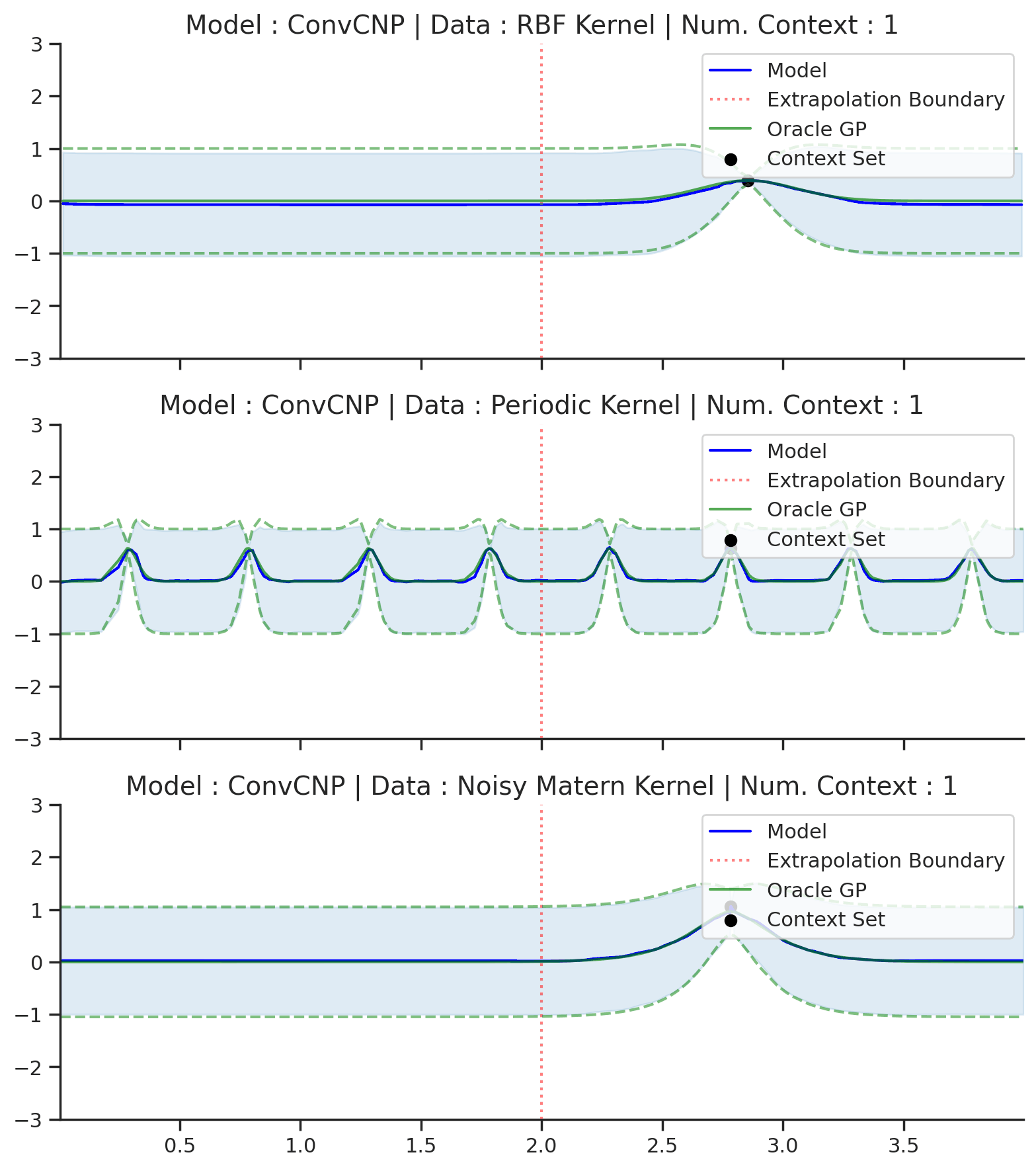
Fig. 57 Posterior predictive of ConvCNPs (Blue line with shaded area for \(\mu \pm \sigma\)) and the oracle GP (Green line with dashes for \(\mu \pm \sigma\)) when conditioned on contexts points (Black) from an underlying function sampled from a GP. Each row corresponds to a different kernel and ConvCNP trained on samples for the corresponding GP. The interpolation and extrapolation regime is delimited delimited by red dashes.¶
Fig. 57 shows that ConvCNP performs very well. Like AttnCNP (Fig. 53) it does not suffer from underfitting, but it has the following advantages compared to AttnCNP:
It can extrapolate outside of the training range due to its translation equivariance. Note that there is no free lunch, this only happens because the underlying stochastic process is stationary.
It is quite smooth and does not have any “kinks”.
It perform quite well on the periodic kernel. Note that it does not recover the underlying GP, for example it has a bounded receptive field and as a result can only model local periodicity.
To better showcase the latter issue, let’s consider a much larger target interval (\([-2,14]\) instead of \([0,4]\)) for the periodic kernel.
def filter_periodic(d):
return {k: v for k, v in d.items() if ("Periodic" in k)}
multi_posterior_gp_gif(
"ConvCNP_periodic_large_extrap",
trainers=filter_periodic(trainers_1d),
datasets=filter_periodic(gp_test_datasets),
right_extrap=12, # makes the target interval 4x larger
)
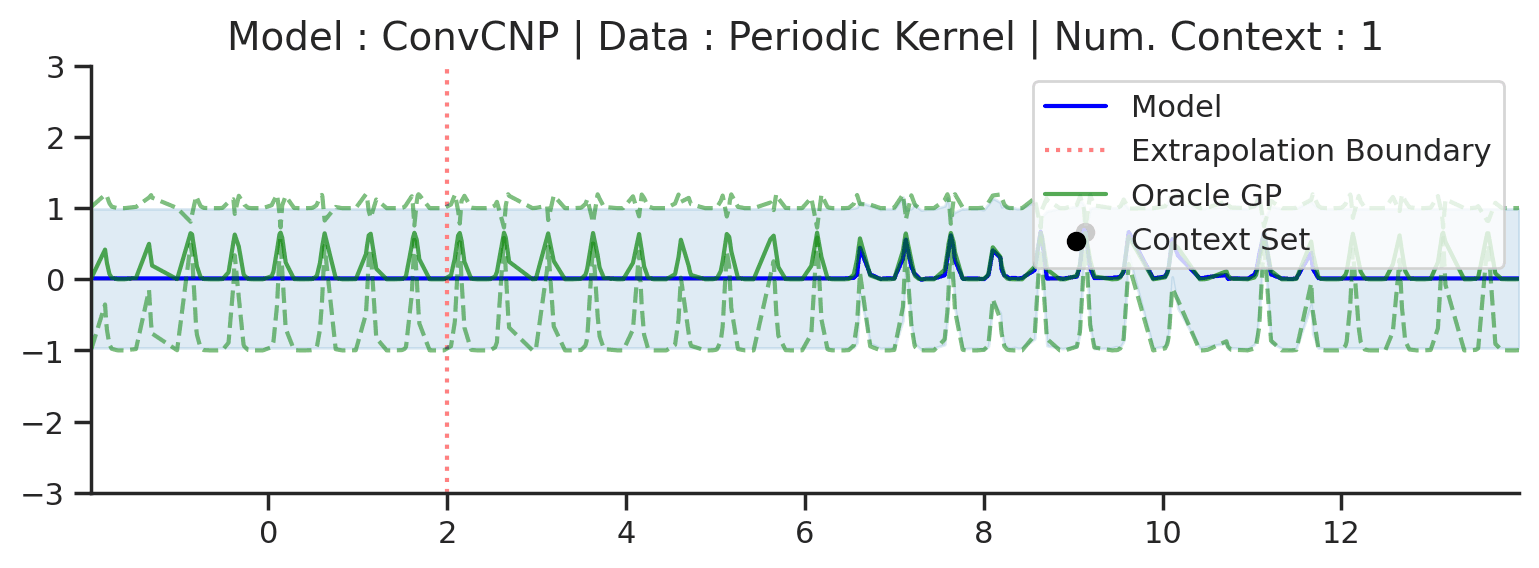
Fig. 58 Same as the 2nd row (Periodic Kernel) of Fig. 57 but with a much larger target interval (\([-2,14]\) instead of \([0,4]\)).¶
Fig. 58 shows that ConvCNP can only model local periodicity, which depends on the receptive field of the CNN.
###### ADDITIONAL 1D PLOTS ######
### Interp ###
multi_posterior_gp_gif(
"ConvCNP_single_gp",
trainers=filter_single_gp(trainers_1d),
datasets=filter_single_gp(gp_test_datasets),
)
### Varying hyperparam ###
def filter_hyp_gp(d):
return {k: v for k, v in d.items() if ("Variable" in k)}
multi_posterior_gp_gif(
"ConvCNP_vary_gp",
trainers=filter_hyp_gp(trainers_1d),
datasets=filter_hyp_gp(gp_test_datasets),
model_labels=dict(main="Model", generator="Fitted GP"),
)
### All kernels ###
# data with varying kernels simply merged single kernels
single_gp_datasets = filter_single_gp(gp_test_datasets)
# use same trainer for all, but have to change their name to be the same as datasets
base_trainer_name = "All_Kernels/ConvCNP/run_0"
trainer = trainers_1d[base_trainer_name]
replicated_trainers = {}
for name in single_gp_datasets.keys():
replicated_trainers[base_trainer_name.replace("All_Kernels", name)] = trainer
multi_posterior_gp_gif(
"ConvCNP_kernel_gp",
trainers=replicated_trainers,
datasets=single_gp_datasets
)
### Sampling ###
def filter_rbf(d):
return {k: v for k, v in d.items() if ("RBF" in k)}
fig = plot_multi_posterior_samples_1d(
trainers=filter_rbf(trainers_1d),
datasets=filter_rbf(gp_test_datasets),
n_cntxt=10,
n_samples=3,
left_extrap=-2,
right_extrap=2
)
fig.savefig(f"jupyter/images/ConvCNP_rbf_samples.png", bbox_inches="tight")
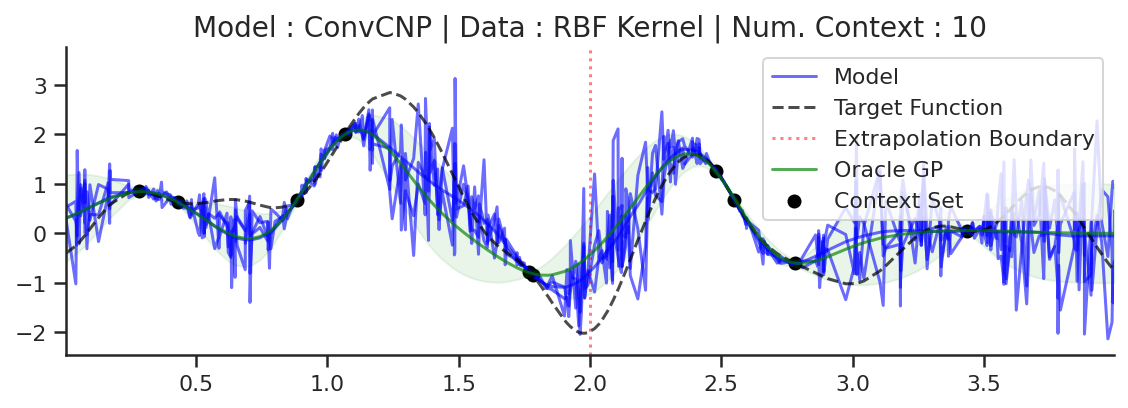
Image Dataset¶
Conditional Posterior Predictive¶
Let us now look at images. We again will use the same plotting function defined in CNP notebook.
from utils.ntbks_helpers import plot_multi_posterior_samples_imgs
from utils.visualize import giffify
SWEEP_VALUES=[
0,
0.005,
0.01,
0.02,
0.05,
0.1,
0.15,
0.2,
0.3,
0.5,
"hhalf", # horizontal half of the image
"vhalf", # vertival half of the image
]
def multi_posterior_imgs_gif(
filename, trainers, datasets, seed=123, n_plots=3, sweep_values=SWEEP_VALUES, fps=1, is_plot_std=True, plot_config_kwargs={"font_scale":0.7}, **kwargs
):
giffify(
save_filename=f"jupyter/gifs/{filename}.gif",
gen_single_fig=plot_multi_posterior_samples_imgs, # core plotting
sweep_parameter="n_cntxt", # param over which to sweep
sweep_values=sweep_values,
fps=fps, # gif speed
# PLOTTING KWARGS
trainers=trainers,
datasets=datasets,
n_plots=n_plots, # images per datasets
is_plot_std=is_plot_std, # plot the predictive std
pretty_renamer=PRETTY_RENAMER, # pretiffy names of modulte + data
plot_config_kwargs=plot_config_kwargs,
# Fix formatting for coherent GIF
seed=seed,
**kwargs,
)
Let us visualize the CNP when it is trained on samples from different image datasets
multi_posterior_imgs_gif(
"ConvCNP_img", trainers=trainers_2d, datasets=img_test_datasets,
)

Fig. 59 Mean and std of the posterior predictive of an ConvCNP for CelebA \(32\times32\), MNIST, and ZSMM for different context sets.¶
From Fig. 59 we see that ConvCNP performs quite well on all datasets when the context set is large enough and uniformly sampled, even when extrapolation is needed (ZSMM). However, it does not perform great when the context set is very small or when it is structured, e.g., half images. Note that seems more of an issue for ConvCNP compared to AttnCNP (Fig. 55). We hypothesize that this happens because the effective receptive field of the former is too small (even though the theoretic size is larger than the image, it does not need such a large receptive field during training so effectively reduces it). For AttnCNP it is harder for the model to change the receptive field during training. This issue can be alleviated by reducing the size of the context set seen during training (to force the model to have a large receptive field).
You might wonder well these models work compared to standard baselines. Let’s visualize that on CelebA128:
multi_posterior_imgs_gif(
"ConvCNP_img_baselines",
trainers=trainers_2dXL,
datasets=imgXL_test_datasets,
sweep_values=[0.005,0.01,0.03,0.05,0.1],
interp_baselines=["nearest","linear","cubic"],
figsize=(18,15),
n_plots=4,
fps=0.7,
plot_config_kwargs=dict(font_scale=1.5)
)
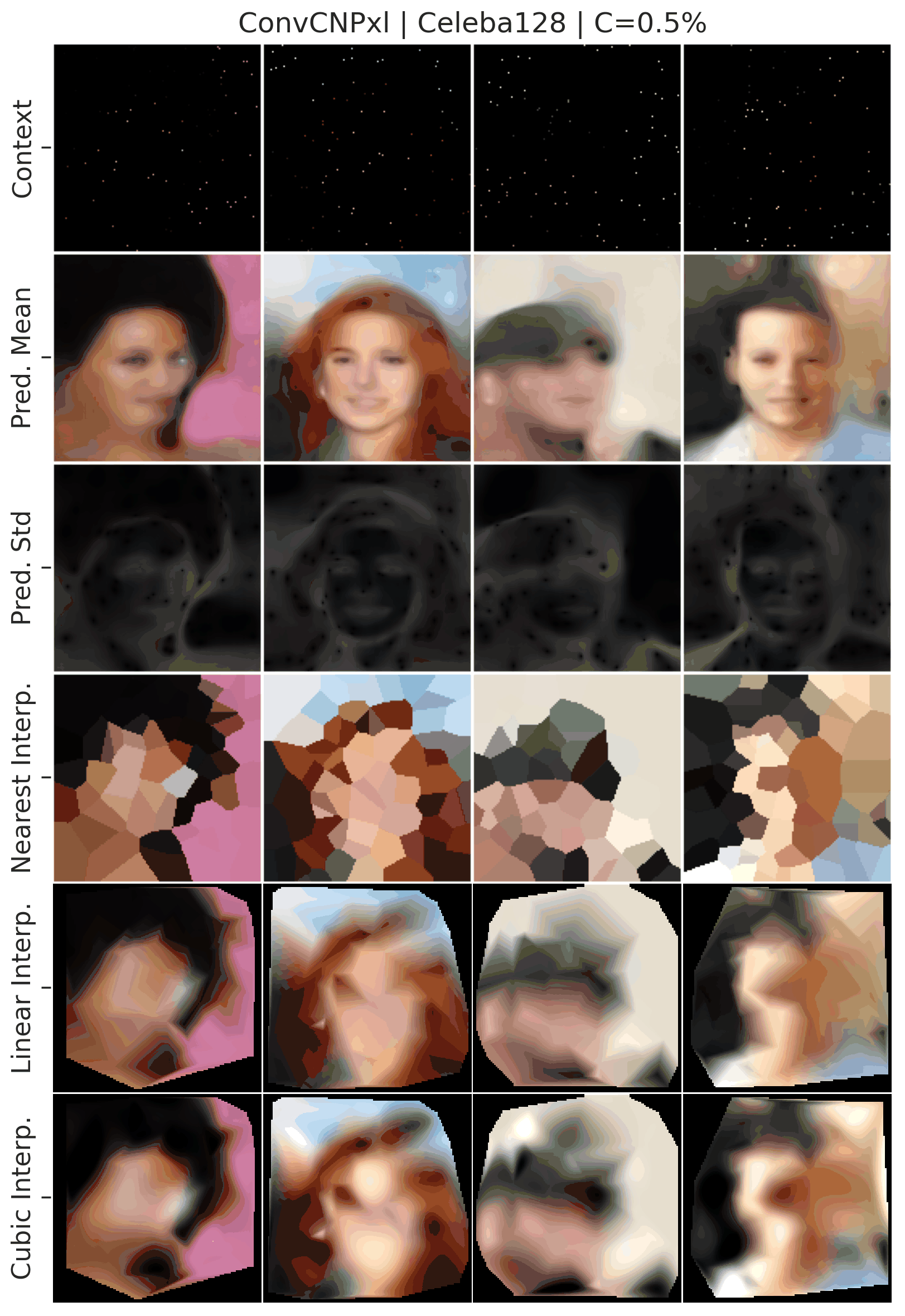
Fig. 60 Posterior predictive of an ConvCNP and of baseline iterpolation methods (nearest neighbour, linear, cubic) for CelebA \(128\times128\) different context sets.¶
From Fig. 25 shows that the results are very impressive and that ConvCNP performs much better than the baselines.
Having seen that the model performs much better than baselines and can even generalize on some artificial dataset (ZSMM). But how does it compare to baselines in real world generalization, namely we will evaluate the large model trained on CelebA128 on a image with multiple faces of different scale and orientation.
import matplotlib.image as mpimg
from utils.data.imgs import SingleImage
img = mpimg.imread("jupyter/images/ellen_selfie_oscars.jpeg")
oscar_datasets = SingleImage(img, resize=(288, 512))
k = "celeba128/ConvCNPXL/run_0"
fig = plot_multi_posterior_samples_imgs(
{k.replace("celeba128", "oscars"): trainers_2dXL[k]},
{"oscars": oscar_datasets},
0.05,
interp_baselines=["linear"],
figsize=(11,9),
plot_config_kwargs=dict(font_scale=1.5)
)
fig.savefig(f"jupyter/images/ConvCNP_img_zeroshot.png", bbox_inches="tight", format="png")
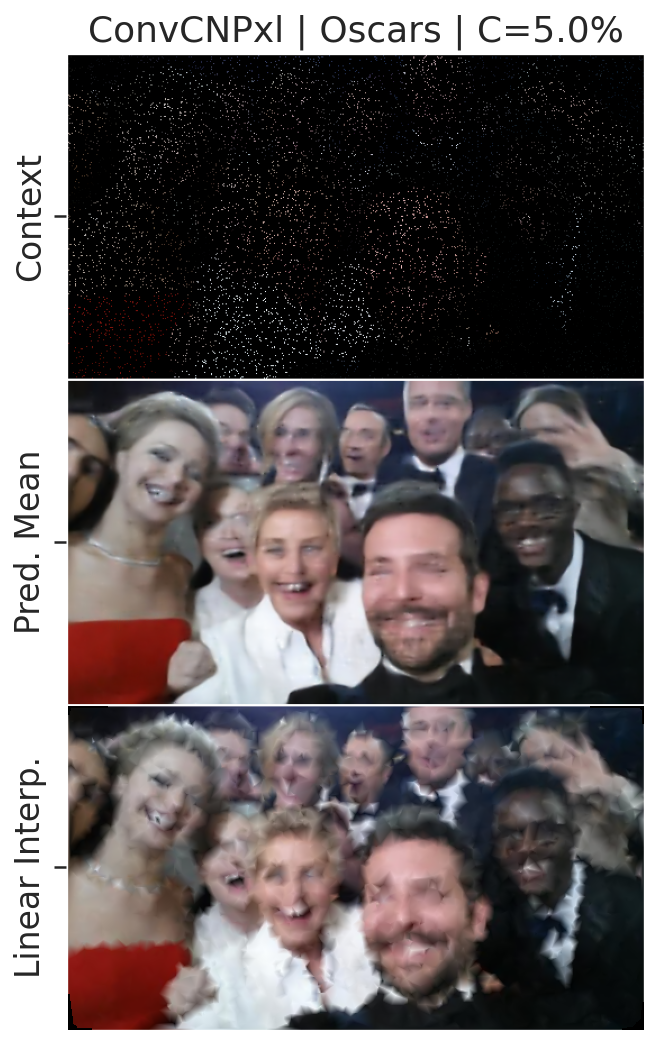
We see that the model is able to reasonably well generalize to real world data in a zero shot fashion.
Increasing Resolution¶
Although the previous results look nice the usecases are not obvious as it is not very common to have missing pixels. One possible application, is increasing the resolution of an image. For the “off the grid” implementation this can be done by setting the target set features between context pixels ([KMS+19]). For the current “on the grid” implementation, this can also be achieved by uniformly spacing out the context pixels on the desired grid size. [^supperres]
Let us define the plotting function for increasing the resolution of an image.
[^supperres] The downside of the “on the grid” method is that it will work best if the desired object size are approximately the same size as those it was trained on.
from utils.ntbks_helpers import plot_multi_posterior_samples_imgs
from utils.visualize import giffify
def superres_gif(filename, trainers, datasets, seed=123, n_plots=3, **kwargs):
giffify(
save_filename=f"jupyter/gifs/{filename}.gif",
gen_single_fig=plot_multi_posterior_samples_imgs, # core plotting is same as before
sweep_parameter="n_cntxt", # param over which to sweep
sweep_values=[1 / 16, 1 / 8, 1 / 4, 1 / 2], # size of the input image
fps=1., # gif speed
# PLOTTING KWARGS
trainers=trainers,
datasets=datasets,
n_plots=n_plots, # images per datasets
is_plot_std=False, # don't predictive std
pretty_renamer=PRETTY_RENAMER, # pretiffy names of modulte + data
is_superresolution=True, # decrease resolution of context image
plot_config_kwargs={"font_scale":0.7},
# Fix formatting for coherent GIF
seed=seed,
**kwargs,
)
superres_gif("ConvCNP_superes",
trainers=trainers_2dXL,
datasets=imgXL_test_datasets)
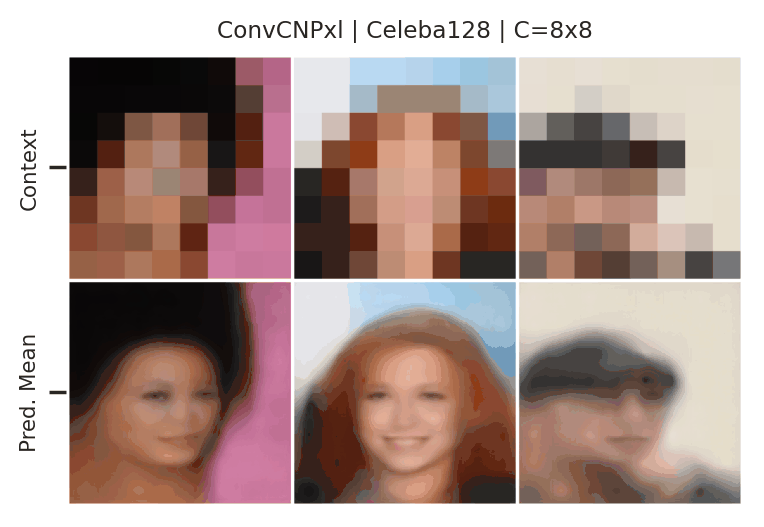
Fig. 61 Increasing the resolution of CelebA to \(128 \times 128\) pixels by querying a ConvCNP a target positions between given pixels.¶
From Fig. 61 we see that NPFs can indeed be used to increase the resolution of an image, even though it was not trained to do so! Results can probably be improved by training NPFs in such setting.
Here are more samples, corresponding to specific percentiles of the test log loss.
from utils.ntbks_helpers import PRETTY_RENAMER
from utils.visualize import plot_qualitative_with_kde
n_trainers = len(trainers_2d)
for i, (k, trainer) in enumerate(trainers_2d.items()):
data_name = k.split("/")[0]
model_name = k.split("/")[1]
dataset = img_test_datasets[data_name]
plot_qualitative_with_kde(
[PRETTY_RENAMER[model_name], trainer],
dataset,
figsize=(7, 5),
percentiles=[1, 10, 20, 30, 50, 100],
height_ratios=[1, 5],
is_smallest_xrange=True,
h_pad=-1,
title=PRETTY_RENAMER[data_name],
)
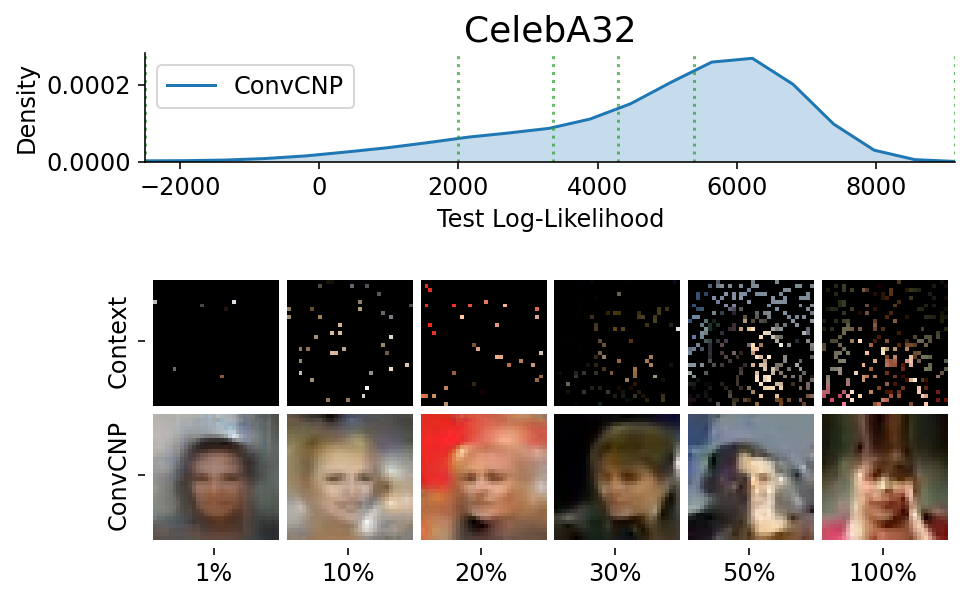
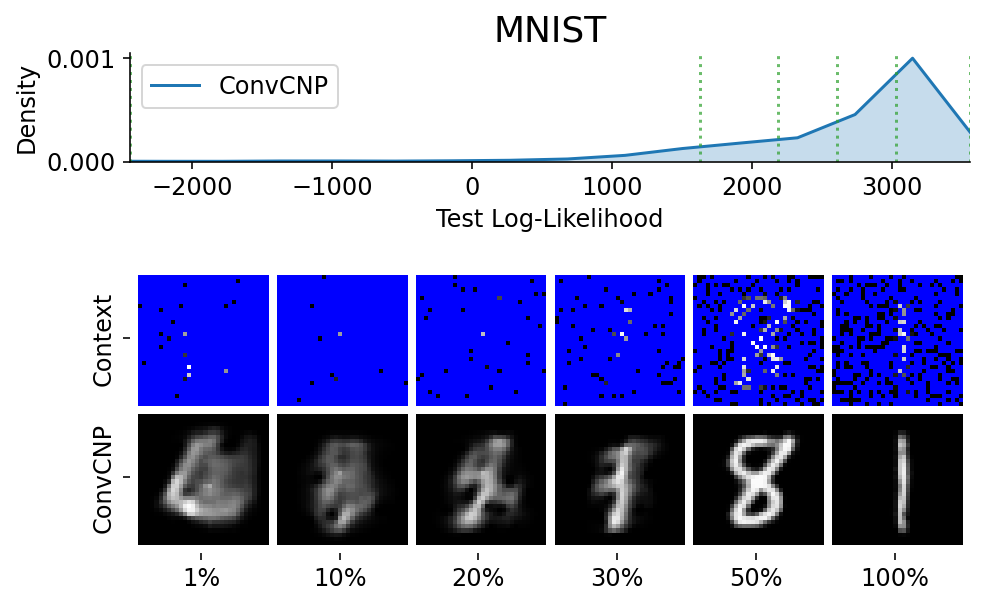
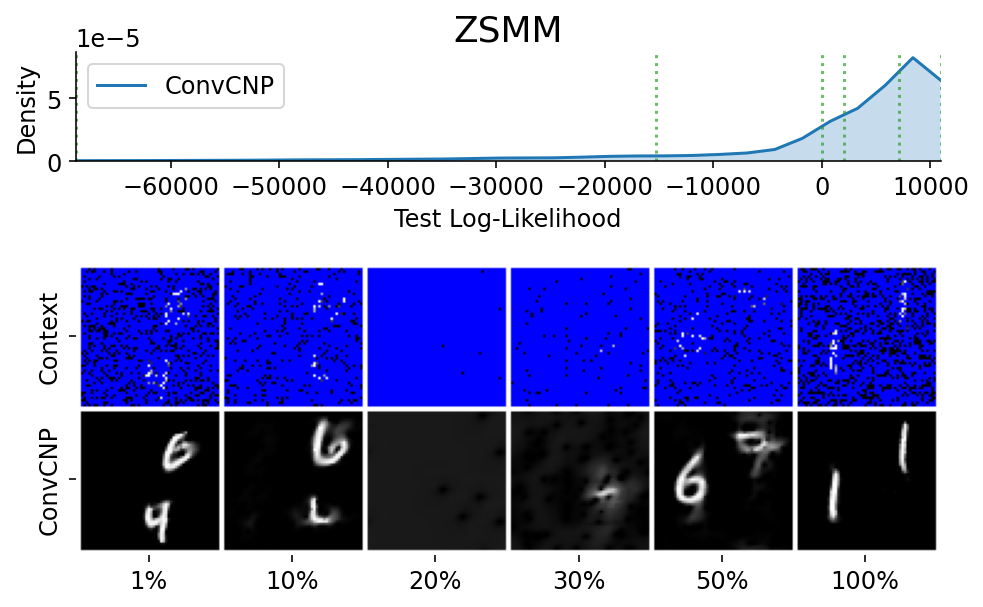
###### ADDITIONAL 2D PLOTS ######
k = "celeba128/ConvCNPXL/run_0"
### Superres png ###
fig = plot_multi_posterior_samples_imgs(
trainers_2dXL,
imgXL_test_datasets,
1 / 8,
is_superresolution=True,
is_plot_std=False,
figsize=(5,5),
)
fig.savefig(f"jupyter/images/ConvCNP_superes.png", bbox_inches="tight")
plt.close(fig)
### Superres png w baseline ###
fig = plot_multi_posterior_samples_imgs(
trainers_2dXL,
imgXL_test_datasets,
1 / 8,
is_superresolution=True,
is_plot_std=False,
figsize=(5,5),
interp_baselines=["linear"]
)
fig.savefig(f"jupyter/images/ConvCNP_superes_baseline.png", bbox_inches="tight")
plt.close(fig)
### Gif Oscar ###
multi_posterior_imgs_gif(
"ConvCNP_img_zeroshot",
{k.replace("celeba128", "oscars"): trainers_2dXL[k]},
{"oscars": oscar_datasets},
fps=0.7,
sweep_values=[0.01,0.03,0.05,0.1,0.3],
figsize=(5,5),
is_hrztl_cat=True,
plot_config_kwargs=dict(font_scale=2)
)
### Superres with baseline ###
superres_gif("ConvCNP_superes_baseline",
trainers=trainers_2dXL,
datasets=imgXL_test_datasets,
interp_baselines=["linear"])
### Interpolation against cubic ###
multi_posterior_imgs_gif(
"ConvCNP_celeba128",
trainers=trainers_2dXL,
datasets=imgXL_test_datasets,
sweep_values=[0.005,0.01,0.03,0.05,0.1],
interp_baselines=["cubic"],
figsize=(18,15),
n_plots=4,
fps=0.7,
plot_config_kwargs=dict(font_scale=1.5)
)
### Superres png ###
fig = plot_multi_posterior_samples_imgs(
trainers_2dXL,
imgXL_test_datasets,
1 / 16,
is_superresolution=True,
is_plot_std=False,
figsize=(15,15),
seed=11,
interp_baselines=["cubic"],
n_plots=3,
title="Upscaling {data_name} 8x8 -> 128x128",
labels=dict(mean="ConvCNP", baseline="Cubic Interp."),
plot_config_kwargs=dict(font_scale=1.7)
)
fig.savefig(f"jupyter/images/ConvCNP_superes_little.png", bbox_inches="tight")
plt.close(fig)
### Zero Shot no baseline ####
img = mpimg.imread("jupyter/images/ellen_selfie_oscars.jpeg")
oscar_datasets = SingleImage(img, resize=(288, 512), missing_px_color=torch.tensor([0., 1., 0.]))
k = "celeba128/ConvCNPXL/run_0"
fig = plot_multi_posterior_samples_imgs(
{k.replace("celeba128", "oscars"): trainers_2dXL[k]},
{"oscars": oscar_datasets},
0.05,
title="ConvCNP Zero Shot Interpolation | Context=5% pixels",
interp_baselines=[],
figsize=(17,12),
plot_config_kwargs=dict(font_scale=1.2),
labels=dict(mean="ConvCNP Interpolation", std="Uncertainty Estimates"),
is_plot_std=True
)
fig.savefig(f"jupyter/images/ConvCNP_img_zeroshot_nobaseline.png", bbox_inches="tight", format="png")
fig.close()
Issues With CNPFs¶
Although ConvCNPFs (and CNPFs) in general perform well, there are definitely some downside compared to other way of modeling stochastic processes.
First, CNPFs cannot be used to sample coherent functions, i.e. although the posterior predictive models well the underlying stochastic process it cannot be used for sampling. Indeed, the posterior predictive factorizes over the target set so there are no dependencies when sampling from the posterior predictive. The samples then look like the mean of the posterior predictive with with some Gaussian noise:
fig = plot_multi_posterior_samples_imgs(
trainers_2d, img_test_datasets, 0.05, n_samples=3, is_plot_std=False, plot_config_kwargs={"font_scale":0.7},
)
fig.savefig(f"jupyter/images/ConvCNP_img_sampling.png", bbox_inches="tight", format="jpeg", quality=80)

An other issue with CNPFs is that the posterior predictive is always Gaussian. For example, let us plot the posterior predictive of a few pixels in MNIST.
from utils.ntbks_helpers import select_labels
from utils.visualize import plot_config, plot_img_marginal_pred
with plot_config(font_scale=1.3, rc={"lines.linewidth": 3}):
fig = plot_img_marginal_pred(
trainers_2d["mnist/ConvCNP/run_0"].module_.cpu(),
select_labels(img_test_datasets["mnist"], 3), # Selecting a 3
GridCntxtTrgtGetter(
RandomMasker(a=0.05, b=0.05), target_masker=no_masker
), # 5% context
figsize=(6, 4),
is_uniform_grid=True, # on the grid model
n_marginals=7, # number of pixels posterior predictive
n_samples=5, # number of samples from the posterior pred
n_columns=2, # number of columns for the sampled
seed=33,
)
fig.savefig(f"jupyter/images/ConvCNP_marginal.png", bbox_inches="tight", format="jpeg", quality=90)
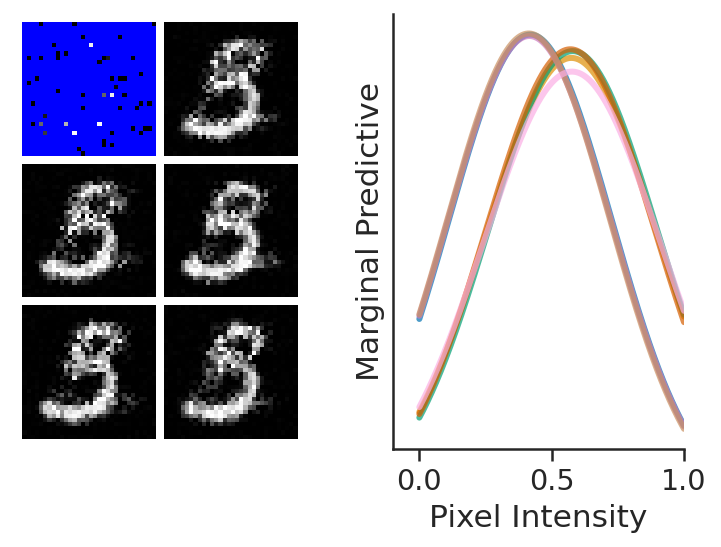
Note that it should be easy to replace the Gaussian with some other simple distribution such as a Laplace one, but it is not easily possible to make the posterior predictive highly complex and multi modal. A possible solution to solve these issues is to introduce latent variables, which we ill investigate in LNPFs notebooks.
Explanation GIF¶
from utils.ntbks_helpers import gif_explain
import copy
# for some reason breaks when running after the rest but not when from the begining
for data in ["RBF","Noisy_Matern","Periodic"]:
for cntxt in [5,10,30]:
dataset = gp_test_datasets[f'{data}_Kernel']
model = copy.deepcopy(trainers_1d[f'{data}_Kernel/ConvCNP/run_0'].module_)
gif_explain(f"jupyter/gifs/explain_convcnp_{data}_{cntxt}cntxt.gif", dataset, model,
plot_config_kwargs=dict(), seed=123, n_cntxt=cntxt, fps=0.5,
length_scale_delta=1.5)

